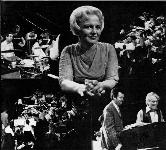PEGGY LEE
Real musical events are rarities. I feel very lucky to have been present at a couple just recently. One took place at the Royal Albert Hall between the hours of 8 and 10 p.m. on June 22, 1970. when Peggy Lee put on an outstanding one–woman show before an ecstatic gathering. Les Tomkins

Interview
After the show, promoter Paddy Malynn said that some ‘friends’ in the States had advised her not to do this concert because she’d be likely to flop.
Well, in fact, this must have been as successful a piece of crowd–pleasing as any in her career, and should result in her returning quite soon for a more extensive engagement.
I have often tried to analyse what it is about Peggy’s singing that, to my mind, puts her head and shoulders above the rest. It seems to have to do with her totally individual style, her endearing sound, her jazz feeling, the very aura that radiates even from a record’s grooves. All these factors—and more, were present throughout this performance. I’m very happy to report that Peggy Lee is alive and well and socking it to ‘em.
From her up–tempo opener “Almost Like Being In Love” through to her closing song two hours later—a plaintive goodbye in several languages—she wooed her public with the showbiz expertise for which she is noted. According to the changing moods of her songs, she was a variety of fascinating blonde–haired women in a long black gown.
Highlights were the dramatic vulnerability of Billie Holiday’s “Don’t Explain”, the jaunty self–assurance of “Spinning Wheel”, “Raindrops Keep Falling On My Head” and “Brother Love’s Travelling Show’, the worldly disillusionment of “Is That All There Is?”, the brassiness of “Big Spender”. The irresistible allure of the soft end of her voice was at its best on lovely ballads like “Watch What Happens”, George Harrison’s “Something”, “I See Your Face Before Me” and a new one to me that could well be one of hers, “What Are You Doing The Rest Of My Life?“.
Then there was what she called a “happy–sad song” by Randy Newman, “You And Me, Babe”.
My only quibble would be that out of 27 songs only about four were uppish in tempo. The rest were slow, or with the slower type of pop eight going on.
I’d have liked to have heard something like that incredible “Lover” she once recorded. But then there’s a few hundred other items from her vast repertoire that I’d have enjoyed. The ones she did were a sheer treat, anyway.
Some of the material in her programme—particularly “Maxwell’s Silver Hammer” wouldn’t sound half as good by anybody else. But she has a magical kind of conception that can transform the most mundane trifle. She really does make them all her own property.
The orchestral backing supplied by the Johnny Howard Concert Orchestra deserves the highest praise. Peggy used a conventional big band set–up, with the addition of a guitar section, as on some albums. The overall sound was of recording studio standard. with nice flute and guitar fills, some stunning trumpet passages (Greg Bowen was in there), and dynamic drumming from Kenny Clare, especially on the eight–beat tunes. Her MD/pianist Lou Levy directed the band and was well to the fore in the scores.
At one point, she stepped back, applauded the orchestra and said how wonderful they were. Backstage, she commented on the fine standard of their playing, considering they’d done seven hours of rehearsal immediately prior to the concert. (They said the same about her singing.) Onstage. she told the audience: “It’s no secret that I love musicians.” At the roar of laughter that went up, she cracked: “That’s one of the reasons I stay on the road.” My personal high–point came towards the end of the evening. Responding to shouted requests. she went into “Fever”, aided superblv by Kenny Clare. Then two more of her great oldies: her original Goodman classic, “Why Don’t You Do Right?“—and here the band played some effective Swing–style riffs behind her—followed quickly by her first hit as a solo recording artist, the self–composed samba, “Manana”.
These well–remembered three proved conclusively that the timbre and quality of her sound are undiminished. Like Sinatra, it’s just that the voice sounds more ‘lived in’ now.
The nine–minute standing ovation she received at the end from the all–age devotees who packed the hall did my heart good. As did the bouquets taken up to her, the hands held out to shake hers, the tears of joy and the throng at the stage door. Peggy Lee is a superstar with a true right to the title. Her triumph stems only from talent.
Copyright © 1970, Les Tomkins. All Rights Reserved